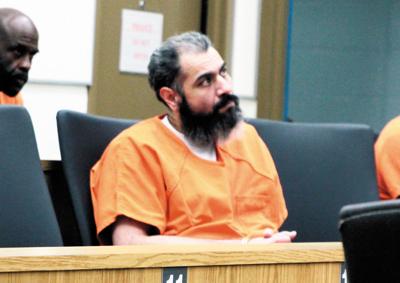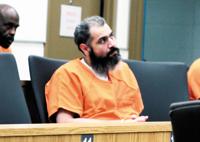JOSHUA TREE — A judge on Thursday, March 20, confirmed a murder charge against a 41-year-old man whose truck overturned in Joshua Tree National Park, killing a passenger, in 2021.
Damien Sousa’s blood tested positive for alcohol, cannabis, MDMA, also known as ecstasy, and LSD, a forensic toxicologist testified in Judge Melissa Rodriguez’s courtroom.
His blood was drawn at Desert Regional Medical Center after his truck overturned on Park Boulevard inside the national park around 7:40 p.m. Sept. 30, 2021. Sousa’s friend Osiris Micali, 29, of Glendora, died on the scene. Sousa and 27-year-old Erica Capidani, who was also in the truck, were hurt.
Three California Highway Patrol officers testified at Thursday’s hearing, where prosecutor Jason Gueltzow presented evidence to convince Rodriguez to hold Sousa to answer on charges of murder, vehicular manslaughter while intoxicated and driving under the influence causing injury.
Officer Joan Griffin recounted interviewing Capidani a few days after the collision.
Capidani said on morning before the crash, she and Sousa were at Micali’s house in the San Dimas area. They decided to go to Joshua Tree National Park, with Sousa driving.
Capidani didn’t remember much about the crash; she was sleeping in the backseat when it happened.
Griffin said Capidani was still visibly injured during the interview.
“Her right eye was black. She told me she had tingling in the back of her head behind her right ear,” Griffin said.
“She had extensive bruising all over her entire body. She had road rash on her knees and right elbow. She also told me that when she walked her left knee popped.”
Officer Ryan Swanson was one of the first on scene at the collision and testified about what he found.
“When I first arrived at the scene, there was a Ford pickup truck that was upside down in the middle of the roadway, blocking both lanes,” he said.
He could see Micali’s legs from beneath the pickup truck. Sousa was standing on the side of the road, behind the truck, Swanson said.
“Did the defendant tell you he was driving the truck?” Gueltzow asked.
“He did,” Swanson responded.
“He said … he had lost control of the vehicle and it ran off the right side of the roadway. Then he over-corrected to the left and the vehicle rolled.”
Swanson said he asked if Sousa had been drinking. “He stated that he had one Sapporo before driving.”
Swanson said Sousa smelled of alcohol and had red eyes. The CHP officer administered three field DUI tests and said Sousa didn’t pass any of them — his eyes bounced when trying to look to the side, he swayed in a circular motion while trying to estimate when 30 seconds had passed, which he guessed at 37 seconds, and he could not touch the tip of his nose.
Swanson administered a breathalyzer test and Sousa’s alcohol content tested at 0.133%, he said.
Swanson said he formed the opinion that Sousa had been driving under the influence and arrested him. Sousa was then taken by ambulance to Desert Regional Medical Center.
Sousa’s attorney, public defender Elizabeth Ulsh, questioned Swanson about his conclusions.
“There’s things other than alcohol that can cause a person’s eyes to be red and watery, correct?” she asked.
“Something like drug use,” Swanson replied.
“Or crying?” Ulsh asked. “Mr. Sousa had just been in a significant accident, correct? And his passenger was trapped underneath, correct?”
“Yes,” Swanson replied.
She also asked about the three field sobriety tests, pointing out only one — tracking Sousa’s horizontal gaze — is part of the standardized battery of tests. Swanson acknowledged the other two are commonly used, but not standardized.
Officer Michael Radford also testified. He also responded to the crash and interviewed a man who was on the road at the same time as Sousa.
The witness told Radford Sousa had passed him in a black Ford F250 going 45-55 mph.
“He said that the truck had a bright light emitting to the rear that was an off-road light that he said was blinding him,” Radford said.
“He slowed down and quickly lost sight of the black F250.”
About two miles down the road, he came across the truck, now overturned, and stopped.
“He stated that there was a female lying on the ground in front of the truck, that he observed the defendant, Mr. Sousa, crawling out of the driver’s seat and there was another male that was trapped underneath the truck,” Radford recalled.
“He related that he believed that he (Sousa) was intoxicated, that he could smell alcohol on his breath and he was slurring his words.”
Lab director testifies on drug and alcohol levels
The final witness was Erin Crabtrey, a forensic toxicologist and laboratory director for Biotox Laboratories in Riverside. She oversaw the tests of Sousa’s blood.
Crabtrey, who has a master’s degree in forensic science from the University of Florida, testified the ethyl alcohol amount in Sousa’s blood was 0.127%.
They also found evidence of MDMA, LSD and Delta-9 THC, which gives marijuana its psychoactive effect.
The amount of Delta-9 THC — 11.1 nanograms per milliliter — suggested to her that Sousa had taken it in the past several hours.
“When I see a level in double digits, this does suggest to me the person had used the drug fairly recently,” she said.
Defense: Not enough evidence for murder charge
Ulsh argued that Sousa should not be charged with murder. In California, a murder charge means the defendant is accused of acting with malicious intent.
A driver who was under the influence when involved in a fatal crash can only be charged with murder if they have been convicted of DUI in the past. That’s because they sign a form acknowledging that driving under the influence is dangerous and if they continue to do it, they could kill someone and be charged with murder. The judge is also supposed to tell the person that in court during sentencing.
Ulsh acknowledged that Sousa had a DUI conviction in 2011 in San Diego County. But she said there was no evidence that he was warned about potential future murder charges.
There is no transcript of his sentencing, so there’s no way to know what the judge advised him, she said.
“Without the transcript, I think that doesn’t give enough evidence of what Mr. Sousa was actually told by the court,” she said.
“I don’t think the prosecution has provided enough evidence to show that Mr. Sousa was actually aware that his actions created that level of risk.”
The judge asked Ulsh about the drugs in Sousa’s blood.
“Miss Crabtrey did not provide information in her testimony as to what LSD or MDMA would actually do to an individual. We don’t know how much LSD was in Mr. Sousa’s system, if it was a tiny amount or a great amount,” Ulsh replied.
The deputy district attorney, Gueltzow, argued that the alcohol amount alone — almost twice the legal limit — was enough to hold Sousa to answer.
He also told the judge that after his last DUI conviction, Sousa was required to complete a class on alcohol abuse, which would have included information on the dangers of driving drunk.
“Certainly Mr. Sousa was aware of the risk at the time he decided to drive a vehicle under the impairments of drugs and alcohol, resulting in death of Osiris Micali,” Gueltzow said.
Rodriguez said based on witness testimony, the blood and drug tests and what they knew about his last conviction, there was probable cause to try Sousa for murder as well as the other charges.
He will be back in court April 3 for an arraignment, where he may plead not guilty, guilty or no contest now that he has heard the evidence against him.


